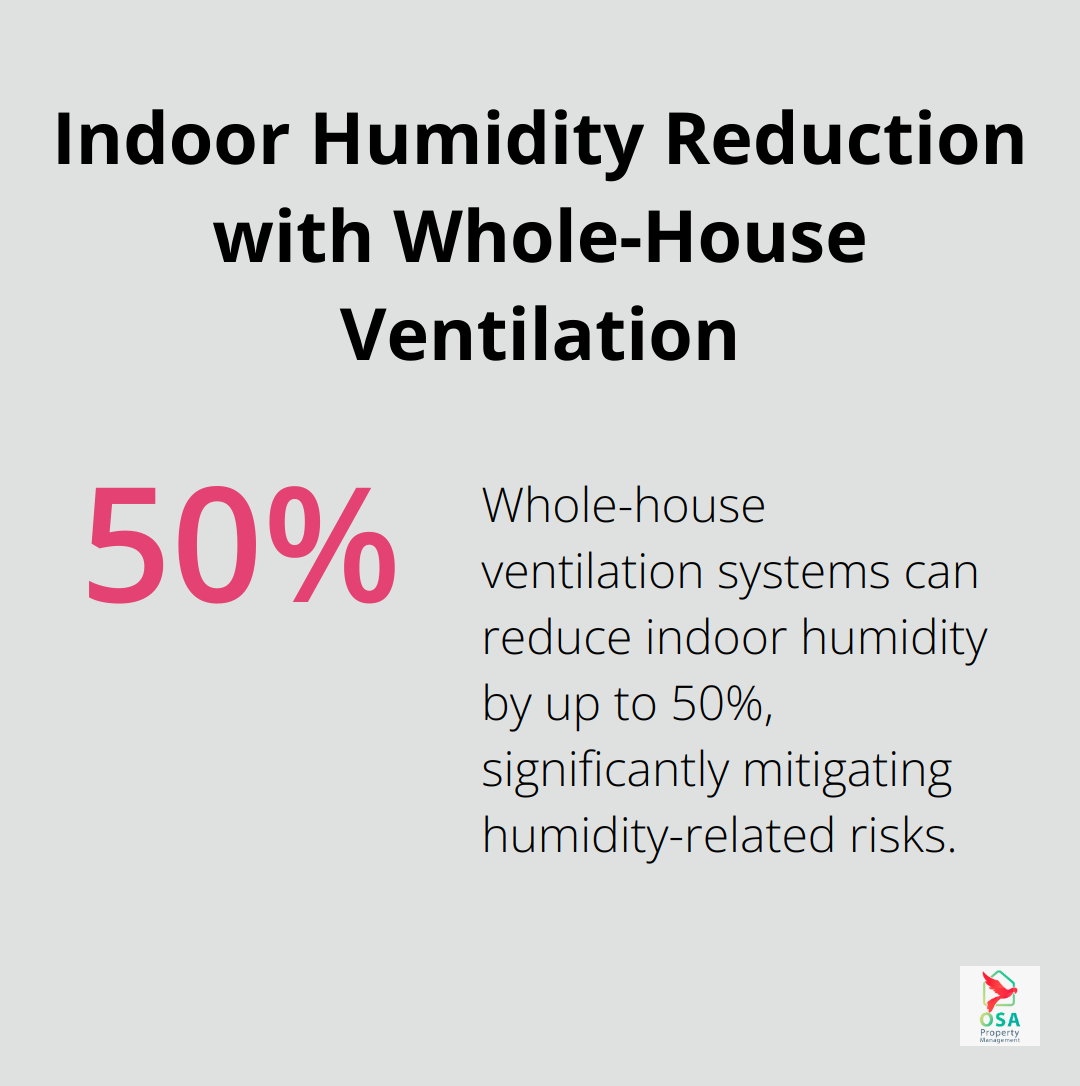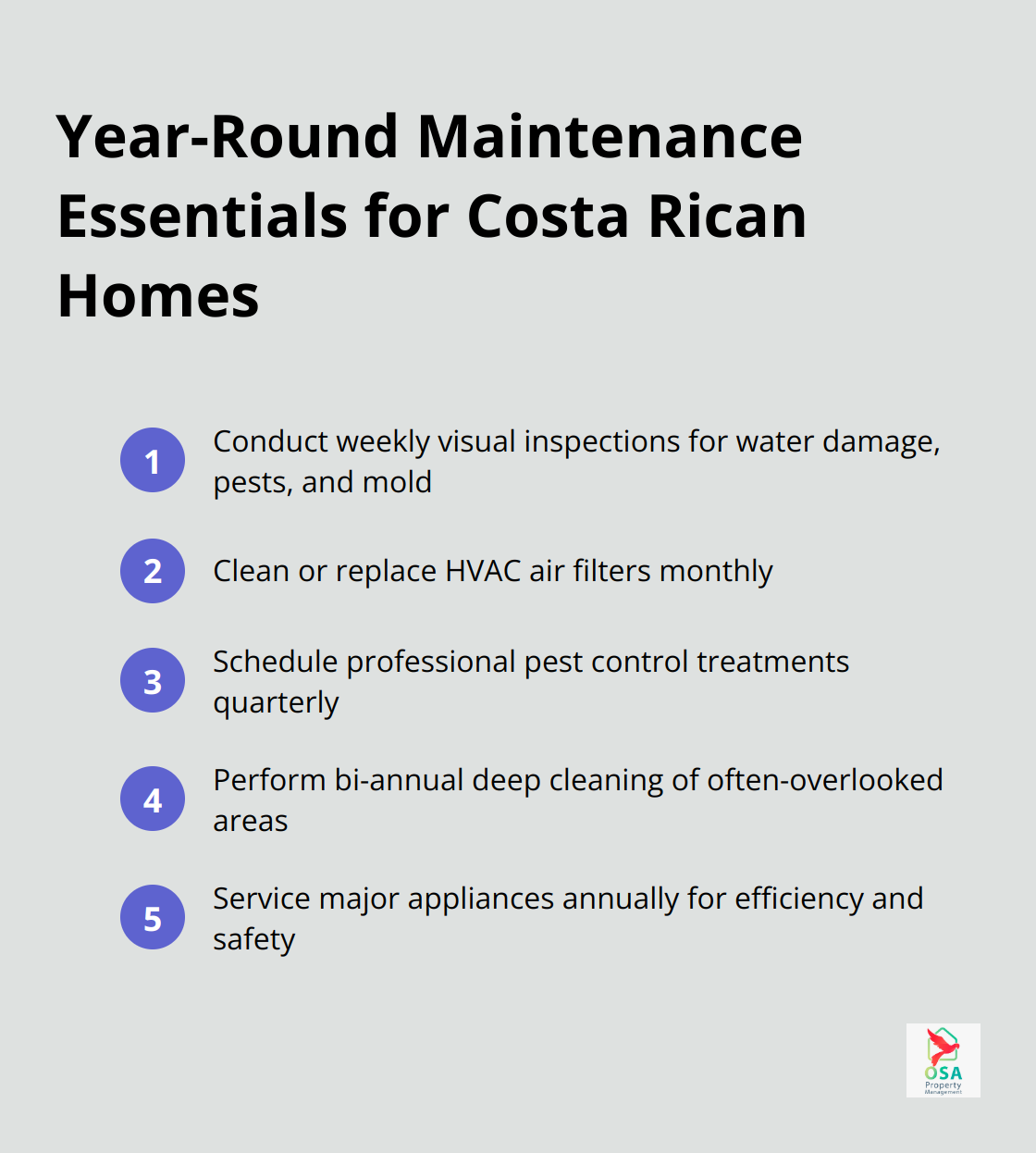Costa Rica’s tropical climate presents unique challenges for homeowners. From intense sun and heavy rainfall to high humidity and persistent pests, maintaining a property in this paradise requires specific knowledge and strategies.
At Osa Property Management, we’ve compiled essential maintenance tips to help you protect your Costa Rican home from the elements. This guide will walk you through key areas of focus and provide a seasonal maintenance schedule to keep your property in top condition year-round.
Costa Rica’s Climate Zones and Their Impact on Homes
Coastal vs. Mountainous Regions
Costa Rica’s tropical climate varies significantly across different zones, each presenting unique challenges for homeowners. The country’s diverse topography creates distinct microclimates that require specific maintenance strategies.
Coastal areas like Jaco and Manuel Antonio experience high humidity and salt air, which accelerate corrosion and mold growth. Homes in these regions need frequent repainting and rust-resistant materials. In contrast, mountainous regions such as Monteverde face cooler temperatures and increased rainfall, necessitating robust drainage systems and regular roof inspections.
Rainfall Patterns and Property Protection
The rainy season in Costa Rica (May to November) brings daily downpours that test the limits of gutters, drains, and foundations. Homeowners must ensure proper water channeling to prevent flooding and structural damage.
Humidity’s Hidden Threats
Humidity levels in Costa Rica typically range from 40 to 85 percent, posing significant threats to homes. It promotes mold growth, warps wood, and damages electronics. Dehumidifiers and proper ventilation play a vital role in combating these issues. Whole-house ventilation systems can reduce indoor humidity by up to 50% (U.S. Department of Energy), which significantly mitigates these risks.

Microclimate-Specific Maintenance
Each microclimate in Costa Rica demands tailored maintenance approaches. For example:
- Coastal properties require corrosion-resistant hardware and frequent inspections for salt damage.
- Homes in rainforest areas need robust gutter systems and mold-resistant paints.
- Mountain properties benefit from additional insulation and heating systems for cooler nights.
Adapting to Seasonal Changes
Property owners must adapt their maintenance routines to Costa Rica’s distinct dry and wet seasons. This includes:
- Dry season: Focus on irrigation, fire prevention, and UV protection for exterior surfaces.
- Wet season: Emphasize drainage maintenance, leak detection, and increased mold prevention measures.
These climate-specific challenges underscore the importance of regular, targeted maintenance. Professional property management services can provide invaluable local expertise to navigate these diverse environmental conditions effectively.
Mastering Home Maintenance in Costa Rica’s Tropical Climate
Costa Rica’s unique climate demands a proactive approach to home maintenance. We’ve identified key areas that require special attention to keep your property in top condition.

Roof Care and Leak Prevention
In Costa Rica’s tropical environment, roofs face constant assault from intense sun, heavy rains, and high humidity. Regular inspections are essential, especially before and after the rainy season. Check for loose or damaged tiles, clear debris from gutters, and ensure proper drainage to prevent water accumulation.
Apply a waterproof sealant every two to three years to significantly extend your roof’s lifespan. For metal roofs (common in Costa Rica), address rust spots promptly. A high-quality rust converter followed by a protective coating will prevent further corrosion.
Combating Mold and Mildew
The high humidity in Costa Rica creates an ideal environment for mold and mildew growth. Dehumidifiers are invaluable tools in this battle (capable of extracting up to 50 pints of water from the air daily in damp areas). This significantly reduces the risk of mold proliferation.
Proper ventilation is equally important. Install ceiling fans in every room to promote air circulation, while bathroom exhaust fans help control moisture in high-humidity areas. For closets and other enclosed spaces, use moisture-absorbing products or small, portable dehumidifiers.
When renovating, opt for mold-resistant materials. Paints with anti-microbial additives can inhibit mold growth for up to five years. Regular cleaning with a mixture of vinegar and water also helps prevent mold growth on surfaces.
Effective Pest Management
Costa Rica’s biodiversity extends to its insect population, making pest control a year-round necessity. Schedule quarterly inspections with a licensed pest control company to catch issues early and minimize infestations.
Natural pest deterrents can be effective for certain pests. Plant lemongrass or marigolds around your property to help reduce mosquito populations. For indoor spaces, essential oils like peppermint or eucalyptus can repel various insects.
Sealing entry points is vital. Inspect your home’s exterior for tiny gaps and seal them with silicone caulk to create a pest-proof barrier. Pay special attention to areas around pipes and where utilities enter the home.
Maintaining Air Conditioning and Ventilation Systems
In Costa Rica’s heat, a well-functioning air conditioning system is essential. Clean or replace filters monthly to improve efficiency and air quality. Professional servicing at least twice a year ensures optimal performance and longevity.
For homes without air conditioning, proper ventilation becomes even more critical. Place windows and doors strategically to create cross-ventilation and significantly improve comfort levels. Consider installing window films to reduce heat gain while maintaining natural light.
Preserving Exterior Surfaces
Costa Rica’s humid climate can cause exterior finishes to deteriorate rapidly without proper maintenance, often within a few years. Use high-quality, UV-resistant paints for exterior walls. Repaint every 3-5 years, depending on sun exposure, to maintain your home’s appearance and structural integrity.
For wood surfaces, regular sealing is imperative. Apply a water-resistant sealant annually to decks, railings, and other exposed wood. This not only protects against moisture but also prevents termite infestations, a common issue in tropical climates.
These maintenance strategies will help protect your Costa Rican home from the challenges of its tropical climate. In the next section, we’ll explore a seasonal maintenance schedule to ensure your property remains in top condition year-round.
Seasonal Maintenance for Costa Rican Homes
Dry Season Priorities (December to April)
The dry season in Costa Rica offers an ideal window for major maintenance projects. With reduced rainfall, outdoor tasks and structural repairs become more manageable. Property owners should focus on these key areas:
Exterior painting: Use the drier weather to repaint exterior surfaces. High-quality, UV-resistant paints protect against sun damage. This task should occur every 2-3 years instead of the standard 3-5 years, depending on sun exposure.
Roof inspections: Conduct a thorough inspection of your roof for any damage from the previous rainy season. Replace damaged tiles or shingles, and apply a fresh coat of waterproof sealant if necessary.
Landscaping maintenance: Cut back trees and shrubs near the house to prevent storm damage. Remove dead branches that could become projectiles in high winds.
Air conditioning service: Book a professional AC tune-up before the hottest months arrive. This ensures peak performance and energy efficiency when you need it most.
Pest control: Perform a comprehensive pest inspection and treatment. The dry season often drives pests indoors in search of water, making this a prime time for prevention.
Rainy Season Preparation (May to November)
As the rainy season approaches, the focus shifts to water management and mold prevention. Property owners should prioritize these tasks:
Gutter cleaning: Remove all debris from gutters and downspouts. Ensure water flows freely away from your home’s foundation. Consider installing gutter guards to reduce future maintenance needs.
Seal openings: Check windows, doors, and other potential entry points for gaps. Apply weatherstripping or caulk to prevent water infiltration during heavy rains.
Mold prevention: Apply mold-inhibiting treatments to susceptible areas like bathrooms and kitchens. Consider using paints with anti-microbial additives for these spaces.
Drainage check: Verify that your property’s drainage systems function correctly. Clear any blockages in French drains or other water diversion systems.
Emergency preparedness: Stock up on essential supplies (flashlights, batteries, and non-perishable food items) in case of power outages during storms.
Year-Round Maintenance Essentials
While some tasks are season-specific, others require consistent attention throughout the year:

This seasonal maintenance schedule can significantly reduce the risk of costly repairs and extend the lifespan of Costa Rican properties. Professional property management services (such as those offered by Osa Property Management) can provide comprehensive maintenance packages tailored to Costa Rica’s unique climate challenges for homeowners who find this schedule overwhelming.
Final Thoughts
Maintaining a home in Costa Rica’s tropical climate requires a proactive approach and attention to detail. Our maintenance tips cover essential aspects such as roof care, mold prevention, pest management, and air conditioning upkeep. These practices protect your property’s value and ensure a comfortable living environment in the face of intense sun, heavy rainfall, and high humidity.
Regular maintenance prevents costly repairs and enhances the longevity of your home’s systems and structures. It improves indoor air quality, reduces energy consumption, and creates a healthier living space. A well-maintained property also retains its market value and appeal, which matters in Costa Rica’s competitive real estate market.
Osa Property Management offers comprehensive services tailored to the unique needs of tropical homes. Their team provides professional maintenance oversight, ensuring all aspects of your property receive care with precision and expertise. Osa Property Management offers peace of mind to homeowners, allowing them to enjoy their Costa Rican paradise without the stress of day-to-day property upkeep (based on their 19 years of experience in areas like Tarcoles, Jaco, Dominical, Manuel Antonio, Ojochal, and Uvita).

